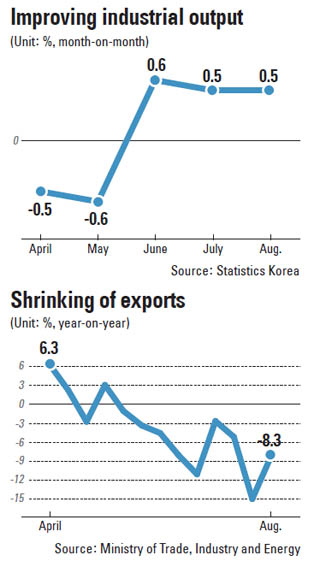Economy shows some life in Aug.

The good news was that industrial output rose 0.5 percent in August from a month earlier, the third month of growth, data from Statistics Korea showed Thursday.
Despite fewer business days during the summer holidays, mining and manufacturing climbed 0.4 percent month on month. Growth in semiconductors and other telecommunication devices led overall production in the manufacturing industry, while automobile and other shipping equipment fell.
Services also gained 0.4 percent, rebounding from the Middle East respiratory syndrome (MERS) outbreak that swept the country in the second quarter. Particular improvement was seen in accommodations and restaurants, which rose 2.3 percent from the previous month.
Inventory in the manufacturing industry rose 0.1 percent in August, and shipments jumped 0.3 percent. Retail sales, a key gauge of domestic consumption, inched up 1.9 percent during the same period, led by a growth in sales of home appliances, clothes and cosmetics.
“In terms of consumption, the impact of MERS has almost vanished, and the government’s measures to stimulate consumption [such as the Korea Grand Sale and the Aug. 14 temporary holiday] also affected [growth in output] quite a lot,” said Jeon Baek-geun, a Statistics Korea official, at a briefing on Thursday. “Releases of new cellphones like the Galaxy Note 5 also drove production in the semiconductor industry and sales in cellphone markets.”
Despite data showing a rebound in the domestic market in August, even fresher data on exports was gloomy. Exports continued to fall in September for the ninth straight month. That cast a deep shadow on Korea’s export-driven economy. Last year, exports accounted for nearly 53 percent of the gross domestic product, nearly double the average of other members of the OECD, which is 27 percent.
Year on year, exports plunged 8.3 percent to $43.5 billion in September, though that was better than the 14.8 percent crash in August, according to statistics released Thursday by the Ministry of Trade, Industry and Energy. Imports fell at a faster rate of 21.8 percent, and the result was the 44 straight months of trade surpluses worth $8.9 billion.
The plunge in global oil prices, which dropped by almost a half in September from a year earlier, put downward pressure on the dollar value of petroleum products. Exports fell 35.3 percent and that of petrochemical products by 25 percent year on year. In total, Korea’s exports in the two industries fell by $2.5 billion in September from the same period last year.
Slower demand from abroad due to a sagging global economy and weak foreign currencies was another major factor, an analysis from the Trade Ministry said. Among the country’s 13 leading export items, only four saw growth from a year earlier: home appliances, auto parts, telecommunication devices such as cellphones, and semiconductors, which are connected to cellphone business.
Shipbuilding, another leading export business, plummeted 20.4 percent during the same period.
Steel exports also fell 21.6 percent in September due to reduced orders from three major importers - the United States, China and Japan - due to slumps in their economies and increasing imports of low-priced products from China, which pushed down average export prices in the global steel industry.
Flat panel displays were affected by a glut of cheaper Chinese products.
BY KIM HEE-JIN [kim.heejin@joongang.co.kr]










with the Korea JoongAng Daily
To write comments, please log in to one of the accounts.
Standards Board Policy (0/250자)